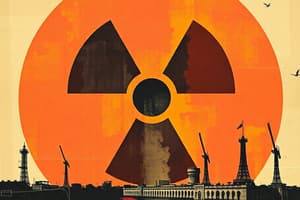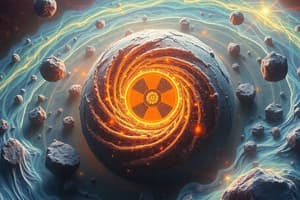Podcast
Questions and Answers
जब एक नाभिक एक अल्फा कण उत्सर्जित करता है तो क्या होता है?
जब एक नाभिक एक अल्फा कण उत्सर्जित करता है तो क्या होता है?
- परमाणु संख्या 2 से बढ़ जाती है और द्रव्यमान संख्या 4 से घट जाती है
- परमाणु संख्या 1 से घट जाती है और द्रव्यमान संख्या अपरिवर्तित रहती है
- परमाणु संख्या 2 से घट जाती है और द्रव्यमान संख्या 4 से घट जाती है (correct)
- परमाणु संख्या 1 से बढ़ जाती है और द्रव्यमान संख्या अपरिवर्तित रहती है
रेडियोधर्मी क्षय को किस प्रकार की प्रक्रिया के रूप में वर्णित किया जा सकता है?
रेडियोधर्मी क्षय को किस प्रकार की प्रक्रिया के रूप में वर्णित किया जा सकता है?
- शून्य क्रम प्रक्रिया
- प्रथम क्रम प्रक्रिया (correct)
- द्वितीय क्रम प्रक्रिया
- तीसरा क्रम प्रक्रिया
निम्नलिखित में से कौन सा रेडियोधर्मी क्षय का प्रकार है जिसमें नाभिक एक इलेक्ट्रॉन उत्सर्जित करता है?
निम्नलिखित में से कौन सा रेडियोधर्मी क्षय का प्रकार है जिसमें नाभिक एक इलेक्ट्रॉन उत्सर्जित करता है?
- अल्फा क्षय
- गामा क्षय
- बीटा क्षय (correct)
- पॉजिट्रॉन उत्सर्जन
रेडियोधर्मी क्षय श्रृंखला क्या है?
रेडियोधर्मी क्षय श्रृंखला क्या है?
एक रेडियोधर्मी समस्थानिक का अर्ध-आयु क्या है?
एक रेडियोधर्मी समस्थानिक का अर्ध-आयु क्या है?
निम्नलिखित में से कौन सी रेडियोधर्मी समस्थानिकों का उपयोग नहीं किया जाता है?
निम्नलिखित में से कौन सी रेडियोधर्मी समस्थानिकों का उपयोग नहीं किया जाता है?
रेडियोधर्मी क्षय की दर किसके समानुपाती होती है?
रेडियोधर्मी क्षय की दर किसके समानुपाती होती है?
एक नाभिक द्वारा एक गामा किरण का उत्सर्जन क्या बदलता है?
एक नाभिक द्वारा एक गामा किरण का उत्सर्जन क्या बदलता है?
कैंसर उपचार में रेडियोधर्मी आइसोटोप का उपयोग किस प्रकार से किया जाता है?
कैंसर उपचार में रेडियोधर्मी आइसोटोप का उपयोग किस प्रकार से किया जाता है?
रेडियोधर्मी अपशिष्ट प्रबंधन में मुख्य ध्यान किस पर दिया जाता है?
रेडियोधर्मी अपशिष्ट प्रबंधन में मुख्य ध्यान किस पर दिया जाता है?
न्यूक्लियाई फ्यूजन प्रक्रिया में क्या होता है?
न्यूक्लियाई फ्यूजन प्रक्रिया में क्या होता है?
किस प्रकार के विकिरण का जैविक प्रभाव अधिक गंभीर होता है?
किस प्रकार के विकिरण का जैविक प्रभाव अधिक गंभीर होता है?
खाद्य संरक्षण में रेडियोधर्मी आइसोटोप का उपयोग किस कार्य के लिए किया जाता है?
खाद्य संरक्षण में रेडियोधर्मी आइसोटोप का उपयोग किस कार्य के लिए किया जाता है?
Flashcards
कैंसर चिकित्सा में रेडियोधर्मी समस्थानिक
कैंसर चिकित्सा में रेडियोधर्मी समस्थानिक
रेडियोधर्मी समस्थानिकों का उपयोग कैंसर कोशिकाओं को नष्ट करने के लिए किया जाता है, जबकि स्वस्थ ऊतकों को कम से कम नुकसान होता है।
औद्योगिक अनुप्रयोगों में रेडियोधर्मी समस्थानिक
औद्योगिक अनुप्रयोगों में रेडियोधर्मी समस्थानिक
रेडियोधर्मी समस्थानिकों का उपयोग विभिन्न औद्योगिक प्रक्रियाओं में किया जाता है, जैसे कि सामग्री की मोटाई मापना, लीक का पता लगाना और उपकरणों के पहनने की निगरानी करना।
रेडियोधर्मी डेटिंग
रेडियोधर्मी डेटिंग
रेडियोधर्मी समस्थानिकों का उपयोग पुरातात्विक कलाकृतियों और भूवैज्ञानिक संरचनाओं की आयु निर्धारित करने के लिए किया जा सकता है।
खाद्य संरक्षण में रेडियोधर्मी समस्थानिक
खाद्य संरक्षण में रेडियोधर्मी समस्थानिक
Signup and view all the flashcards
रेडियोधर्मी कचरा प्रबंधन
रेडियोधर्मी कचरा प्रबंधन
Signup and view all the flashcards
रेडियोधर्मिता क्या है?
रेडियोधर्मिता क्या है?
Signup and view all the flashcards
अल्फा क्षय क्या है?
अल्फा क्षय क्या है?
Signup and view all the flashcards
बीटा क्षय क्या है?
बीटा क्षय क्या है?
Signup and view all the flashcards
गामा क्षय क्या है?
गामा क्षय क्या है?
Signup and view all the flashcards
रेडियोधर्मिता का क्षय दर क्या है?
रेडियोधर्मिता का क्षय दर क्या है?
Signup and view all the flashcards
अर्ध आयु क्या है?
अर्ध आयु क्या है?
Signup and view all the flashcards
रेडियोधर्मी क्षय श्रृंखला क्या है?
रेडियोधर्मी क्षय श्रृंखला क्या है?
Signup and view all the flashcards
रेडियोधर्मी आइसोटोप के चिकित्सा उपयोग क्या हैं?
रेडियोधर्मी आइसोटोप के चिकित्सा उपयोग क्या हैं?
Signup and view all the flashcards
Study Notes
Introduction to Radioactivity
- Radioactivity is the spontaneous emission of particles or energy from the nucleus of an unstable atom.
- This process occurs naturally in some elements and can be induced artificially through nuclear reactions.
- Unstable atoms, or radioisotopes, attempt to achieve a more stable nuclear configuration by emitting energy as radiation.
Types of Radioactive Decay
- Alpha decay: The nucleus emits an alpha particle, a helium nucleus (2 protons and 2 neutrons). This decreases the atomic number by 2 and the mass number by 4.
- Beta decay: A neutron transforms into a proton, emitting a beta particle (an electron) and an antineutrino. This increases the atomic number by 1, while the mass number remains the same.
- Gamma decay: The nucleus releases high-energy photons (gamma rays). This doesn't affect the atomic number or mass number.
- Positron emission: A proton transforms into a neutron, emitting a positron (a positively charged electron) and a neutrino. This decreases the atomic number by 1 but keeps the mass number unchanged.
- Electron capture: The nucleus captures an inner electron, converting a proton into a neutron. This releases a neutrino and decreases the atomic number by 1, while the mass number stays the same.
Radioactive Decay Laws
- Radioactive decay is a first-order process, its rate depends solely on the number of unstable nuclei present.
- The decay rate is proportional to the number of radioactive nuclei.
- Half-life is the time it takes for half a sample to decay.
- The decay constant (λ) relates decay rate to radioactive nuclei. Decay rate formula: dN/dt = -λN
Radioactive Decay Series
- Radioactive isotopes decay into other unstable isotopes, forming a decay series or chain.
- Each isotope in the series has a distinct half-life.
- The decay series ends with a stable, non-radioactive isotope.
Uses of Radioactive Isotopes
- Medical imaging: Radioisotopes help diagnose and treat diseases. Tracers highlight specific organs/tissues in scans (e.g., PET, SPECT).
- Cancer therapy: Targeted radioisotopes destroy cancer cells, minimizing harm to healthy tissues.
- Industrial applications: Radioisotopes are used in gauging material thickness, detecting leaks and monitoring equipment.
- Dating: Radioactive isotopes determine the age of artifacts and geological formations.
- Food preservation: Irradiation with radioisotopes eliminates harmful microorganisms, extending shelf life and preserving nutrition.
Radioactive Waste Management
- Handling and storing radioactive materials ensures public safety and environmental protection.
- Different radioactive waste types require specific storage methods, considering intensity and half-life.
- Methods for disposal vary, aiming to reduce hazards and prevent contamination.
Biological Effects of Radiation
- Ionizing radiation damages biological molecules, especially DNA.
- Radioisotopes emit ionizing radiation with varying penetrating power and energy levels, affecting tissues differently.
- High radiation doses cause acute radiation sickness; chronic low-dose exposure may lead to long-term health problems, including cancer.
- Damage depends on dose, radiation type and tissue affected.
Nuclear Reactions
- Nuclear reactions alter atomic nuclei.
- Fission: A heavy nucleus splits into two or more lighter nuclei, releasing vast energy.
- Fusion: Two light nuclei combine into a heavier nucleus, also releasing significant energy.
- Nuclear reactors exploit controlled fission reactions to generate energy.
Studying That Suits You
Use AI to generate personalized quizzes and flashcards to suit your learning preferences.




